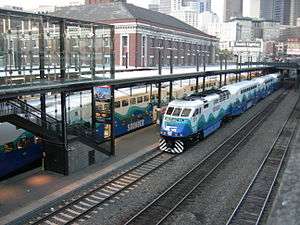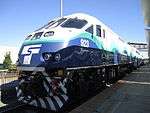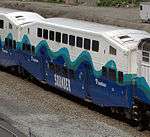Sounder commuter rail
|
| |||
 Two Sounder trainsets at King Street Station in Seattle | |||
| Overview | |||
|---|---|---|---|
| Owner | Sound Transit | ||
| Locale | Seattle metropolitan area | ||
| Transit type | Commuter rail | ||
| Number of lines | 2 | ||
| Number of stations | 12 | ||
| Daily ridership | 18,314 (October 2017)[1] | ||
| Annual ridership | 4,438,374 (2017)[2] | ||
| Website | Sounder Rider Guide | ||
| Operation | |||
| Began operation |
September 18, 2000 (South Line) December 26, 2003 (North Line) | ||
| Operator(s) | BNSF Railway | ||
| Reporting marks | SDRX | ||
| Number of vehicles |
14 locomotives 67 passenger cars[3] | ||
| Train length |
North Line: 1 locomotive, 2 or 3 passenger cars South Line: 1 locomotive, 7 passenger cars | ||
| Technical | |||
| System length | 83 mi (134 km) | ||
| Track gauge | 4 ft 8 1⁄2 in (1,435 mm) (standard gauge) | ||
| Top speed | 79 mph (127 km/h) | ||
| |||
Sounder commuter rail (reporting mark SDRX) is a regional rail service operated by BNSF on behalf of Sound Transit.[4] Service operates Monday through Friday during peak hours from Seattle, Washington, north to Everett and south to Lakewood.
As of 2017, schedules serve the traditional peak commutes, with most trains running inbound to Seattle in the morning and outbound in the afternoon. Three daily round-trips run the reverse commute to and from Tacoma.[5] Additional Sounder trains operate on some Saturdays and Sundays for travel to and from Seahawks and Sounders games at CenturyLink Field and Mariners games at Safeco Field. Both stadiums are a short walk from King Street Station.
Service history
North Line
The 35-mile (56 km) Everett-to-Seattle line started with a Seahawks Game train on December 21, 2003. Regular service started on the 22nd with one morning train to Seattle and one evening train back. A second round trip train was added on June 6, 2005 to help increase ridership, a third was added in September 2007. In September 2008, an additional train was added to the line, bringing the total number to four round trips in the peak direction. There are currently three stops along the North Line: Edmonds, Mukilteo, and Everett. On May 31, 2008, service to Mukilteo station began.[6][7]
Additionally, Sound Transit partners with Amtrak Cascades to allow Sounder riders to use the two trains per day that Amtrak Cascades operates to Bellingham, WA and Vancouver, BC through the RailPlus program. This allows commuters to use the Sounder fare structure between Everett and Seattle. The program is available only to riders who use monthly passes. The Amtrak Cascades trains do not stop at Mukilteo nor does Amtrak's Empire Builder from Chicago, Illinois.
Weekday ridership on the North Line was roughly 1,100 in 2010.[8] and was about 1,561 in the first quarter of 2016[9]. Trains on the North Line have been prone to frequent cancellation due to mudslides throughout its history,[10] though WSDOT has begun construction to remedy the problem.[11]
South Line
The South Line began service with two round trip trains on September 18, 2000 with stops in Tacoma, Sumner and Auburn that terminated in Seattle. Puyallup and Kent stations were added February 5, 2001, with Tukwila being added March 12, 2001. There are currently thirteen round trips on the South Line, with three operating in the reverse commute direction.[5]
In July 2010, Sound Transit reached a new agreement with BNSF, valued at $185 million, which grants Sound Transit permanent access to the South Line corridor, as well as allowing four more daily round trips to begin, starting in 2012 and continuing through 2017.[12]
On October 8, 2012, the extension to South Tacoma and Lakewood stations was inaugurated, with five daily round trips, all of which are in the peak direction, serving the new stations.[13] In September 2016, a mid-day round trip was added between Lakewood and Seattle.[14] In September 2017, two additional round trips were added, bringing the total to eight daily round trips servicing the Lakewood extension.[15][5]
The average weekday ridership in 2010 on the South Line was 8,300, down 7% from 2009 due to continued low employment in Downtown Seattle. Since then the average ridership has increased and as of October 2015 stood at 14,500 per day.[16] In 2016, ridership was 14,731 per day.[17]
Future expansion
Sound Transit plans to add additional Sounder South Line stations at Tillicum and DuPont. The track has already been constructed by Sound Transit with funding from WSDOT as part of the Amtrak Cascades Point Defiance Bypass project. The construction of the stations will be funded by the Sound Transit 3 ballot measure passed in 2016. The two stations are expected to open in 2036 and cost $300 million.[18] In addition, Sound Transit plans to extend station platform lengths on the south line to accommodate trains up to ten cars in length, up from the current seven.[19]
Fares
As with Link light rail, Sounder operates using a proof-of-payment fare system. Passengers are required to purchase a paper ticket or tap their ORCA card (and receiving a valid permit to travel) before boarding trains. Sound Transit fare inspectors or police officers randomly board trains and check for valid proof-of-payment. Passengers who are caught traveling without valid proof-of-payment are subject to a fine.
The fares for Sounder are distance-based. Passengers who pay using ORCA must tap their cards before boarding and after alighting trains. Passengers using ORCA are charged the maximum fare from the station they are traveling from and are issued a permit to travel when they tap before boarding and, if necessary, receive a refund when they tap after boarding.
Discounted fares are offered for youth, seniors and the disabled, and low-income riders qualifying for the ORCA Lift program. As of April 2017, adult fares for Sounder are as follows:[20]
North Line
| Everett | |||
|---|---|---|---|
| $3.25 | Mukilteo | ||
| $4.00 | $3.75 | Edmonds | |
| $5.00 | $4.50 | $4.00 | Seattle |
South Line
| Lakewood | ||||||||
|---|---|---|---|---|---|---|---|---|
| $3.25 | South Tacoma | |||||||
| $3.50 | $3.25 | Tacoma | ||||||
| $4.00 | $3.75 | $3.50 | Puyallup | |||||
| $4.00 | $4.00 | $3.50 | $3.25 | Sumner | ||||
| $4.50 | $4.25 | $4.00 | $3.50 | $3.50 | Auburn | |||
| $4.75 | $4.50 | $4.25 | $4.00 | $3.75 | $3.25 | Kent | ||
| $5.00 | $5.00 | $4.50 | $4.25 | $4.00 | $3.75 | $3.25 | Tukwila | |
| $5.75 | $5.50 | $5.25 | $4.75 | $4.75 | $4.25 | $4.00 | $3.75 | Seattle |
Ridership statistics
Data from Sound Transit[21]
| Year | 2004 | 2005 | 2006 | 2007 | 2008 | 2009 | 2010 | 2011 | 2012 | 2013 | 2014 | 2015 | 2016 | 2017[22] |
|---|---|---|---|---|---|---|---|---|---|---|---|---|---|---|
| Ridership | 955,298 | 1,268,291 | 1,692,971 | 2,156,652 | 2,668,623 | 2,492,362 | 2,364,290 | 2,543,955 | 2,811,891 | 3,035,735 | 3,361,317 | 3,812,040 | 4,162,641 | 4,438,374 |
| YoY Diff. % | — | 33% | 34% | 27% | 24% | -7% | -5% | 8% | 11% | 8% | 11% | 13% | 8% | 6% |
Fleet
| Model | Manufactured | Road Numbers | Number In Fleet | Notes | Image |
|---|---|---|---|---|---|
| Locomotives | |||||
| EMD F59PHI | 1999 | 901–904 | 4 | All locomotives rebuilt with engines that meet the Tier 3 EPA standard to reduce emissions and provide fuel savings.[23] | .jpg) |
| 2000 | 905–906 | 2 | |||
| 2001 | 907–911 | 5 | |||
| MotivePower MP40PH-3C | 2012 | 921–923 | 3 | Upgraded to comply with the Tier 3 emissions standard |  |
| Cab Cars | |||||
| Bombardier BiLevel cab car | 1999 | 101–104 | 4 | .jpg) | |
| 2000 | 105–111 | 7 | 112–118 sold to Caltrain.[24] | ||
| 2003 | 301–307 | 7 | |||
| 2017 | 321–329 | 9 |  | ||
| Coaches | |||||
| Bombardier BiLevel Coach | 2000 | 201–213 | 13 |  | |
| 2001 | 214–215 | 2 | |||
| 2002 | 216–218, 227–228, 231–240 | 15 | 219–226 & 229–230 sold to Caltrain.[24] | ||
| 2003 | 401–410 | 10 | |||
| Sources (unless noted otherwise):[25][26] | |||||
References
- ↑ "October 2017 Service Performance Report" (PDF). Sound Transit. December 7, 2017. Retrieved December 8, 2017.
- ↑ "Service Delivery: Quarterly Performance Report - Fourth Quarter, 2017" (PDF). Sound Transit. February 22, 2018. Retrieved February 22, 2018.
- ↑ "2016 Service Implementation Plan - Appendix B: Fleet Plans" (PDF). Sound Transit. pp. 138–139. Retrieved April 6, 2017.
- ↑ "Sounder Commuter Rail Train Specifications". Sound Transit. 2009-07-18. Archived from the original on 2009-08-02. Retrieved 2008-02-10.
- 1 2 3 "Sound Transit: Sounder Commuter Rail Schedules". Sound Transit. Retrieved April 6, 2017.
- ↑ Pesznecker, Scott (May 31, 2008). "Sounder begins service to Mukilteo today". Everett Herald. Everett Herald. Retrieved 2008-05-31.
- ↑ "Mukilteo Station". Sound Transit. 2008-02-10. Retrieved 2008-02-10.
- ↑ 2011 SIP, page 26 Archived 2011-08-10 at the Wayback Machine.
- ↑ "2016 Q1 Report" (PDF).
- ↑ "Mudslides continue to plague rail traffic north of Seattle".
- ↑ "Work starts on landslide solutions for Pacific Northwest Rail Corridor".
- ↑ "Sound Transit approves four new Seattle-Tacoma round trips". Trains Magazine. 23 July 2010. Retrieved 23 July 2010.
- ↑ Hall, C.B. (November 21, 2012). "Sounder train gets a lackluster start in Lakewood". Crosscut. Retrieved May 2, 2017.
- ↑ "South Sounder line to start mid-day service in September". Seattle Times. August 30, 2016. Retrieved April 6, 2017.
- ↑ "Sounder south gets better than ever with new trips starting 9/25". Sound Transit. August 24, 2017. Retrieved December 8, 2017.
- ↑ "October 2015 Ridership Summary" (PDF). www.soundtransit.org.
- ↑ "2016 Q1 Report" (PDF).
- ↑ Lynn, Adam (March 24, 2016). "Several Pierce County projects in $50 billion Sound Transit plan". The News Tribune. Retrieved December 20, 2016.
- ↑ "South Sounder Capital Improvements Program" (PDF). Sound Transit. July 1, 2016. Retrieved April 6, 2017.
- ↑ "Sounder train fares". Sound Transit. Retrieved April 6, 2017.
- ↑ "Quarterly Ridership Report archive". Sound Transit. Retrieved April 12, 2017.
- ↑ "2017 Ridership".
- ↑ "MOTION NO. M2016-123 Sounder Locomotive Overhaul Contract Amendment" (PDF). Sound Transit. December 15, 2016. Retrieved February 25, 2017.
- 1 2 "Sound Transit Motion No. M2001-72". Sound Transit. Archived from the original (PDF) on 2010-06-20.
- ↑ "Draft 2015 Service Implementation Plan - Appendix B: Fleet Plans" (PDF). Sound Transit. p. 112. Archived from the original (PDF) on 8 November 2014. Retrieved 8 November 2014.
- ↑ "Sound Transit". Canadian Public Transportation Discussion Board Wiki. Retrieved 20 December 2014.
External links
Route map:
| Wikimedia Commons has media related to Sounder commuter rail. |